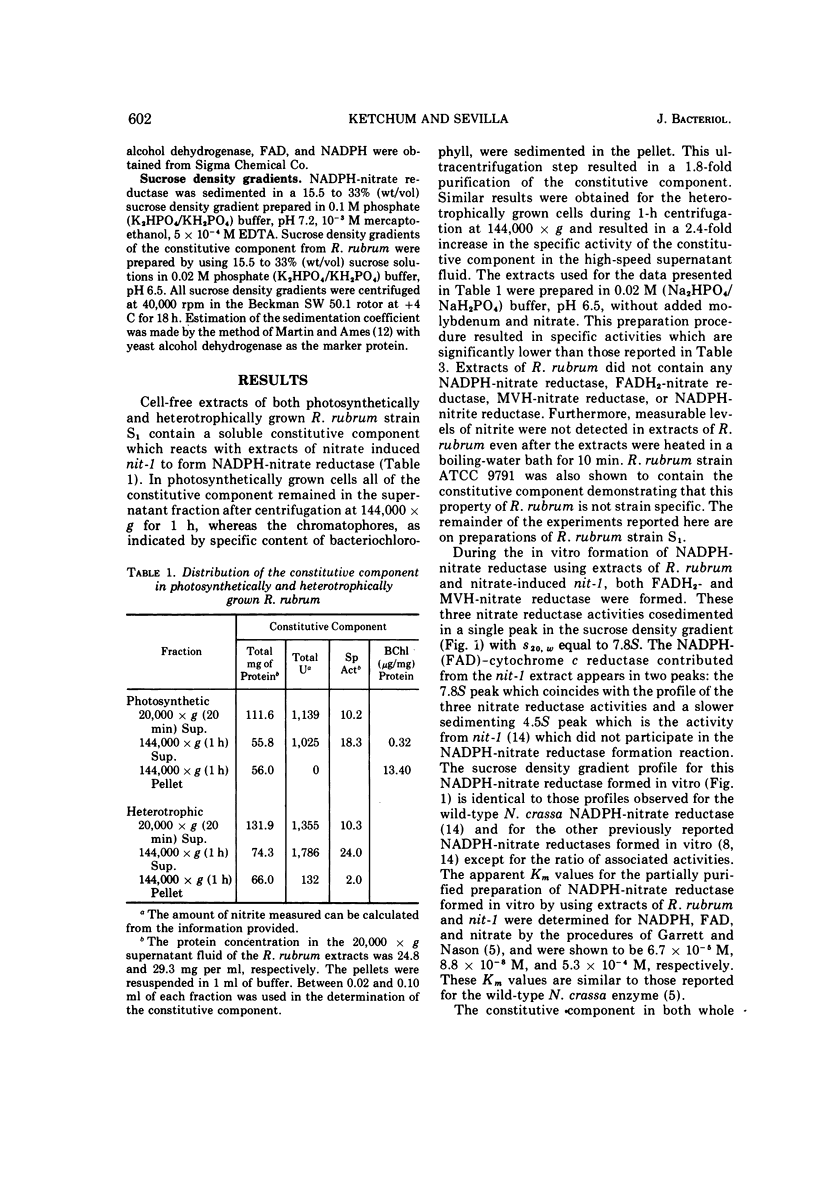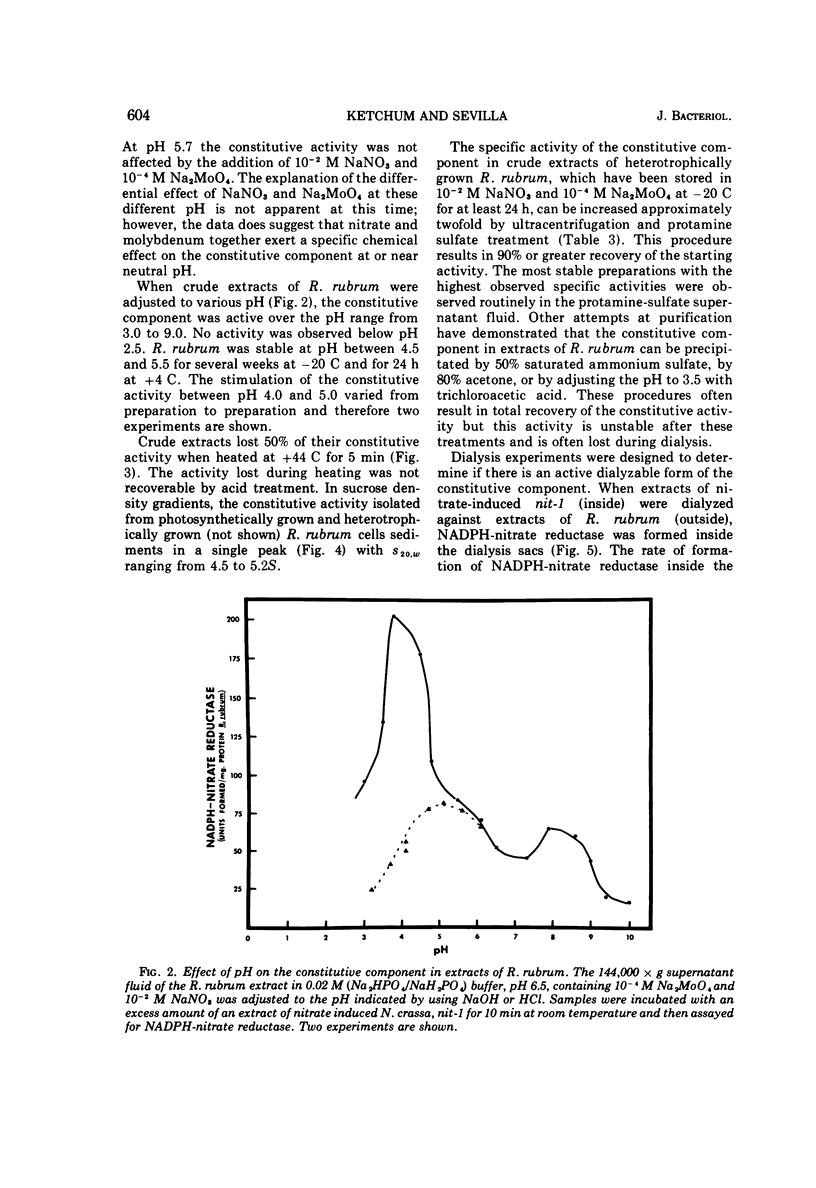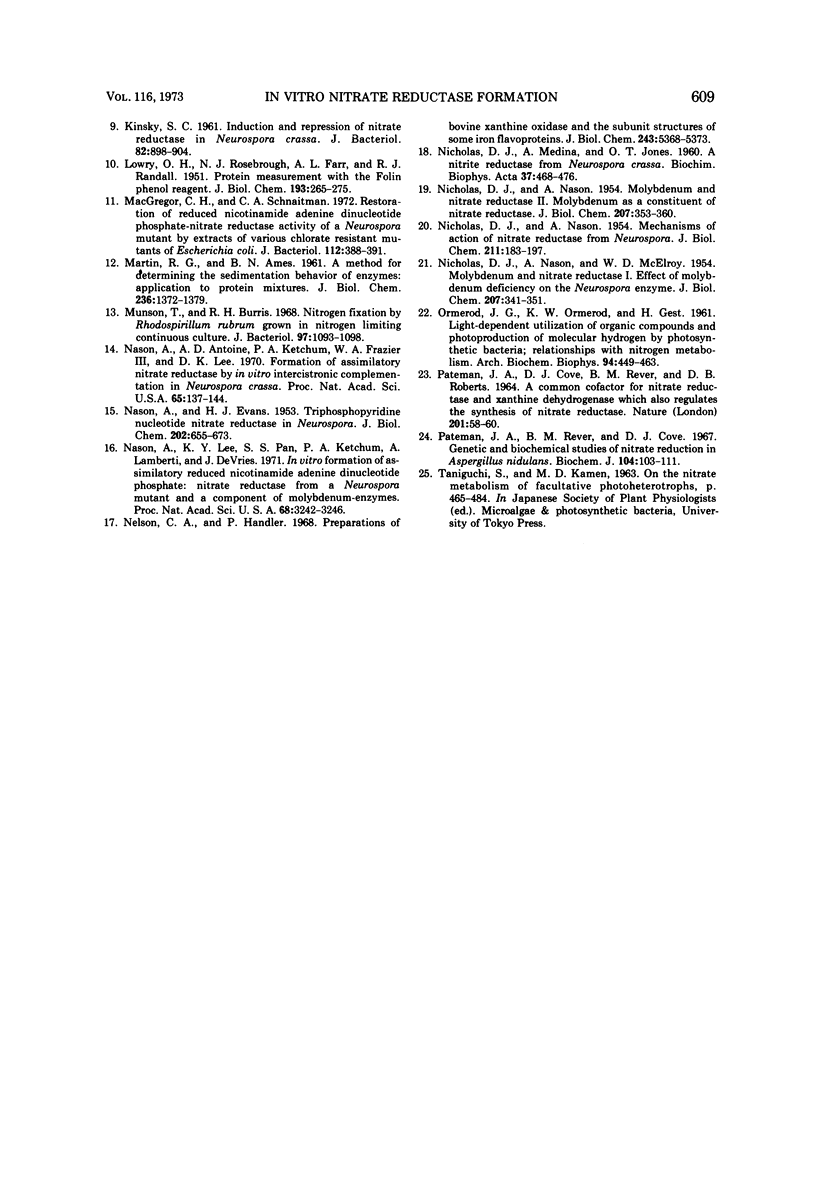Abstract
In vitro formation of reduced nicotinamide adenine dinucleotide phosphate (NADPH)–nitrate reductase (NADPH: nitrate oxido-reductase, EC 1.6.6.2) has been attained by using extracts of the nitrate reductase mutant of Neurospora crassa, nit-1, and extracts of either photosynthetically or heterotrophically grown Rhodospirillum rubrum, which contribute the constitutive component. The in vitro formation of NADPH-nitrate reductase is characterized by the conversion of the flavin adenine dinucleotide (FAD) stimulated NADPH-cytochrome c reductase, contributed by the N. crassa nit-1 extract from a slower sedimenting form (4.5S) to a faster sedimenting form (7.8S). The 7.8S NADPH-cytochrome c reductase peak coincides in sucrose density gradient profiles with the NADPH–nitrate reductase, FADH2–nitrate reductase and reduced methyl viologen (MVH)–nitrate reductase activities which are also formed in vitro. The constitutive component from R. rubrum is soluble (both in heterotrophically and photosynthetically grown cells), is stimulated by the addition of 10−4 M Na2MoO4 and 10−2 M NaNO3 to cell-free preparations, and has variable activity over the pH range from 3.0 to 9.5. The activity of the constitutive component in some extracts showed a threefold stimulation when the pH was lowered from 6.5 to 4.0. The constitutive activity appears to be associated with a large molecular weight component which sediments as a single peak in sucrose density gradients. However, the constitutive component from R. rubrum is dialyzable and is insensitive to trypsin and protease. These results demonstrate that R. rubrum contains the constitutive component and suggests that it is a low molecular weight, trypsin- and protease-insensitive factor which participates in the in vitro formation of NADPH nitrate reductase.
Full text
PDF









Selected References
These references are in PubMed. This may not be the complete list of references from this article.
- Burns R. C., Bulen W. A. A procedure for the preparation of extracts from Rhodospirillum rubrum catalyzing N2 reduction and ATP-dependent H2 evolution. Arch Biochem Biophys. 1966 Feb;113(2):461–463. doi: 10.1016/0003-9861(66)90215-3. [DOI] [PubMed] [Google Scholar]
- Cook R. A., Koshland D. E., Jr Specificity in the assembly of multisubunit proteins. Proc Natl Acad Sci U S A. 1969 Sep;64(1):247–254. doi: 10.1073/pnas.64.1.247. [DOI] [PMC free article] [PubMed] [Google Scholar]
- Garrett R. H., Nason A. Further purification and properties of Neurospora nitrate reductase. J Biol Chem. 1969 Jun 10;244(11):2870–2882. [PubMed] [Google Scholar]
- Garrett R. H., Nason A. Involvement of a B-type cytochrome in the assimilatory nitrate reductase of Neurospora crassa. Proc Natl Acad Sci U S A. 1967 Oct;58(4):1603–1610. doi: 10.1073/pnas.58.4.1603. [DOI] [PMC free article] [PubMed] [Google Scholar]
- KINSKY S. C. Induction and repression of nitrate reductase in Neurospora crassa. J Bacteriol. 1961 Dec;82:898–904. doi: 10.1128/jb.82.6.898-904.1961. [DOI] [PMC free article] [PubMed] [Google Scholar]
- Ketchum P. A., Cambier H. Y., Frazier W. A., 3rd, Madansky C. H., Nason A. In vitro assembly of Neurospora assimilatory nitrate reductase from protein subunits of a Neurospora mutant and the xanthine oxidizing or aldehyde oxidase systems of higher animals. Proc Natl Acad Sci U S A. 1970 Jul;66(3):1016–1023. doi: 10.1073/pnas.66.3.1016. [DOI] [PMC free article] [PubMed] [Google Scholar]
- LOWRY O. H., ROSEBROUGH N. J., FARR A. L., RANDALL R. J. Protein measurement with the Folin phenol reagent. J Biol Chem. 1951 Nov;193(1):265–275. [PubMed] [Google Scholar]
- MARTIN R. G., AMES B. N. A method for determining the sedimentation behavior of enzymes: application to protein mixtures. J Biol Chem. 1961 May;236:1372–1379. [PubMed] [Google Scholar]
- MacGregor C. H., Schnaitman C. A. Restoration of reduced nicotinamide adenine dinucleotide phosphate-nitrate reductase activity of a Neurospora mutant by extracts of various chlorate-resistant mutants of Escherichia coli. J Bacteriol. 1972 Oct;112(1):388–391. doi: 10.1128/jb.112.1.388-391.1972. [DOI] [PMC free article] [PubMed] [Google Scholar]
- Munson T. O., Burris R. H. Nitrogen fixation by Rhodospirillum rubrum grown in nitrogen-limited continuous culture. J Bacteriol. 1969 Mar;97(3):1093–1098. doi: 10.1128/jb.97.3.1093-1098.1969. [DOI] [PMC free article] [PubMed] [Google Scholar]
- NASON A., EVANS H. J. Triphosphopyridine nucleotide-nitrate reductase in Neurospora. J Biol Chem. 1953 Jun;202(2):655–673. [PubMed] [Google Scholar]
- NICHOLAS D. J., MEDINA A., JONES O. T. A nitrite reductase from Neurospora crassa. Biochim Biophys Acta. 1960 Jan 29;37:468–476. doi: 10.1016/0006-3002(60)90503-5. [DOI] [PubMed] [Google Scholar]
- NICHOLAS D. J., NASON A., McELROY W. D. Molybdenum and nitrate reductase. I. Effect of molybdenum deficiency on the Neurospora enzyme. J Biol Chem. 1954 Mar;207(1):341–351. [PubMed] [Google Scholar]
- NICHOLAS D. J., NASON A. Mechanism of action of nitrate reductase from Neurospora. J Biol Chem. 1954 Nov;211(1):183–197. [PubMed] [Google Scholar]
- NICHOLAS D. J., NASON A. Molybdenum and nitrate reductase. II. Molybdenum as a constituent of nitrate reductase. J Biol Chem. 1954 Mar;207(1):353–360. [PubMed] [Google Scholar]
- Nason A., Antoine A. D., Ketchum P. A., Frazier W. A., 3rd, Lee D. K. Formation of assimilatory nitrate reductase by in vitro inter-cistronic complementation in Neurospora crassa. Proc Natl Acad Sci U S A. 1970 Jan;65(1):137–144. doi: 10.1073/pnas.65.1.137. [DOI] [PMC free article] [PubMed] [Google Scholar]
- Nason A., Lee K. Y., Pan S. S., Ketchum P. A., Lamberti A., DeVries J. Invitro formation of assimilatory reduced nicotinamide adenine dinucleotide phosphate: nitrate reductase from a Neurospora mutant and a component of molybdenum-enzymes. Proc Natl Acad Sci U S A. 1971 Dec;68(12):3242–3246. doi: 10.1073/pnas.68.12.3242. [DOI] [PMC free article] [PubMed] [Google Scholar]
- Nelson C. A., Handler P. Preparation of bovine xanthine oxidase and the subunit structures of some iron flavoproteins. J Biol Chem. 1968 Oct 25;243(20):5368–5373. [PubMed] [Google Scholar]
- ORMEROD J. G., ORMEROD K. S., GEST H. Light-dependent utilization of organic compounds and photoproduction of molecular hydrogen by photosynthetic bacteria; relationships with nitrogen metabolism. Arch Biochem Biophys. 1961 Sep;94:449–463. doi: 10.1016/0003-9861(61)90073-x. [DOI] [PubMed] [Google Scholar]
- PATEMAN J. A., COVE D. J., REVER B. M., ROBERTS D. B. A COMMON CO-FACTOR FOR NITRATE REDUCTASE AND XANTHINE DEHYDROGENASE WHICH ALSO REGULATES THE SYNTHESIS OF NITRATE REDUCTASE. Nature. 1964 Jan 4;201:58–60. doi: 10.1038/201058a0. [DOI] [PubMed] [Google Scholar]
- Pateman J. A., Rever B. M., Cove D. J. Genetic and biochemical studies of nitrate reduction in Aspergillus nidulans. Biochem J. 1967 Jul;104(1):103–111. doi: 10.1042/bj1040103. [DOI] [PMC free article] [PubMed] [Google Scholar]


